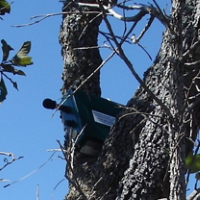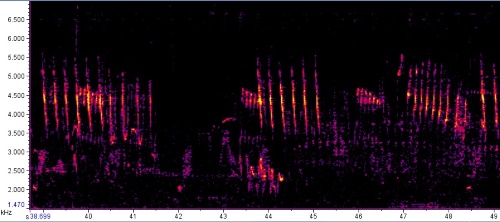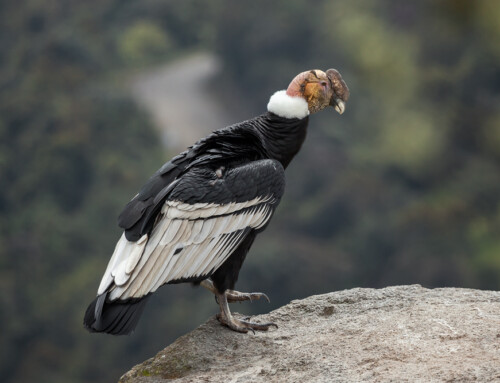Can automatic recorders facilitate field research and improve avian monitoring?
LINKED PAPER
Comparisons between autonomous acoustic recordings and avian point count in open woodland savanna. Alquezar, R.D. and Machado, R.B. 2015. The Wilson Journal of Ornithology, DOI: 10.1676/14-104.1 VIEW
Autonomous recording units (ARU) are a useful technology that is gaining increased importance as an aid in monitoring biodiversity acoustically. This method allows the researcher to sample many areas simultaneously, eliminating temporal differences between samples and reducing the required time for fieldwork (Hobson et al. 2002, Buxton and Jones 2012).
ARU does not require skilled observers in the field (Haselmayer and Quinn 2000, Hobson et al. 2002), and the absence of human influence reduces disturbance of activities and behavior of the birds being surveyed (Acevedo and Villanueva-Rivera 2006). A further advantage is that recordings obtained through ARU deployment create a permanent record of the studied site (Haselmayer and Quinn 2000, Acevedo and Villanueva-Rivera 2006, Celis-Murillo et al. 2009), providing information for several studies and future comparisons.
Figure 1 Recording from Cerrado. Image created with Raven Pro 1.5.
Conversely, the technique requires more time and effort to process data (Hutto and Stutzman 2009), species that seldom vocalize can be missed, and some species may remain unidentified due to the absence of visual cues when producing only short calls (Acevedo and Villanueva-Rivera 2006).
Considering all advantages and disadvantages of using this methodology instead of the usual point counts, studies that have investigated possible differences between the conventional and the technological methodology have found no consensual result. Variations may occur due to differences in equipment used, vegetation structure or as a result of the richness and composition of the bird community itself (see original paper for studies’ comparison table).
Our study’s objective was to evaluate usefulness of ARU for avian monitoring in a tropical savanna, comparing the performance of ARU (SongMeter SM2+ – Wildlife Acoustics Inc., Maynard, MA, USA) and point counts conducted by field observers in the Cerrado (woodland savanna).
The Cerrado is a tropical biome found mainly in Brazil, but with extensions to Bolivia and Paraguay. It is a mosaic of natural vegetation types that varies from open grasslands to semideciduous or deciduous forests (Eiten 1972) where canopy cover can vary from zero in grasslands to 100% in forest formations. Cerrado sensu stricto is the most common physiognomy found in the biome and its canopy cover ranges from 40 to 60%. It includes scattered small, medium and tall trees (Figure 1) and comprises a rich avifauna of approximately 420 species, of which 36 are endemic (Da Silva 1997, Marini and Garcia 2005).
Figure 2 Cerrado sensu stricto – vegetation structure.
Our study was conducted in Brazil, at the Federal District (Brasília city) and Goiás state (Figure 2). We sampled 13 points simultaneously with ARU and point counts, during September and November of 2012.
Figure 3 Study area. Number 1 corresponds to Federal District (DF) region and Brasilia National Park (gray area). Number 2 corresponds to areas in Goiás state (GO) and Chapada dos Veadeiros National Park (gray area). Points located outside these two large protected areas correspond to other sampled localities. The gray area on the South America map represents the limits of the Brazilian Cerrado.
When we analyzed each pair of sample (ARU vs. simultaneous point count), we found no significant differences (paired t-test) between number of species detected by point counts and ARU techniques. In total, we have found 84 species in 968 records. Of the 968 records, 81 species were detected in point counts by the observer (483 records) and 76 by the ARU (485 records). Results showed 68% similarity (Jaccard’s similarity index – Figure 3) between species recorded in each sample point, by the different methods.
Figure 4 Similarity of species composition in each method and sample. The bars represent different samples, with detections made by both methods simultaneously in the center, and those made by each method independently at the ends.
We also evaluated errors associated to each methodology, and found that ARU missed 17% of total species registered in all points, while observer missed 10%. However, for each point, ARU detected more species than observer, and observer missed 16% of registers made by ARU. These results suggest that both methods are equivalent in open woodlands, and show that no methodology is perfect by itself. The huge advantage of using ARU consists of the possibility of sampling the same point several times at different times of the day, reducing the errors associated to the methodology and increasing the chance of detecting more species that may be silent at the time of a single point count (Acevedo and Villanueva-Rivera 2006).
Acoustic Biodiversity monitoring based on bioacoustics techniques may require the use of automated methods to process large amounts of data acquired by ARU, since it is very difficult to process all the information in a short time period. One possible approach is to use recognition software to identify species present in the recording. The main problem associated with automated recognition software is that most of them do not work properly in noisy environments due to low signal-to-noise ratios (Kogan and Margoliash 1998, Chen and Maher 2006), and they fail to identify species when several individuals sing at the same time. In addition, most of this software recognizes syllables rather than complete songs, making it harder to work with different species at the same time because of the number of different syllables that may occur in a species’ repertoire.
New promising approaches on the processing of large amounts of data in monitoring projects are focused not on species but on the community as a whole (Sueur et al. 2008, Pieretti et al. 2011, Towsey et al. 2014). Studies conducted in France revealed that the use of an acoustic index is valid and can reflect the diversity of a community of animals (birds, in that case; Depraetere et al. 2012).
Although ARU and point counts presented similar and complementary results, ARUs have been shown to be valuable tools that can be used to detect birds in open Cerrado areas and that can increase studies in monitoring communities, especially if semi-automatic or automatic analyses are used. This combination can increase the information base and the accuracy of decisions in management and conservation of species. Additionally, we expect that techniques of species or community recognition will improve with time and thus be applicable to regions with high biodiversity, such as the tropics.
References and further reading
Acevedo M.A. & Villanueva-Rivera L.J. (2006) Using Automated Digital Recording Systems as Effective Tools for the Monitoring of Birds and Amphibians. Wildlife Society Bulletin, 34:211-214. View
Buxton R.T. & Jones I.L. (2012) Measuring nocturnal seabird activity and status using acoustic recording devices: applications for island restoration. Journal of Field Ornithology, 83:47-60. View
Celis-Murillo A., Deppe J.L. & Allen M.F. (2009) Using soundscape recordings to estimate bird species abundance, richness, and composition. Journal of Field Ornithology, 80:64-78. View
Chen Z. & Maher R.C. (2006) Semi-automatic classification of bird vocalizations using spectral peak tracks. The Journal of the Acoustical Society of America, 120:2974-2984. View
Da Silva J.M.C. (1997) Endemic bird species and conservation in the Cerrado Region, South America. Biodiversity and Conservation, 6:435-450. View
Depraetere M., Pavoine S., Jiguet F., Gasc A., Duvail S. & Sueur J. (2012) Monitoring animal diversity using acoustic indices: implementation in a temperate woodland. Ecological Indicators, 13:46-54. View
Eiten G. (1972) The Cerrado vegetation of Brazil. The Botanical Review, 38:201-327. View
Haselmayer J. & Quinn J.S. (2000) A comparison of point counts and sound recording as bird survey methods in Amazonian southeast Peru. The Condor, 102:887-893. View
Hobson K.A., Rempel R.S., Greenwood H., Turnbull B. & Van Wilgenburg S.L. (2002) Acoustic Surveys of Birds Using Electronic Recordings: New Potential from an Omnidirectional Microphone System. Wildlife Society Bulletin, 30:709-720. View
Hutto R.L. & Stutzman R.J. (2009) Humans versus autonomous recording units: a comparison of point-count results. Journal of Field Ornithology, 80:387-398. View
Kogan J.A. & Margoliash D. (1998) Automated recognition of bird song elements from continuous recordings using dynamic time warping and hidden Markov models: A comparative study. Journal of Acoustical Society of America, 103:2185-2196. View
Marini M Â. & Garcia F.I. (2005) Bird Conservation in Brazil. Conservation Biology, 19:665-671. View
Pieretti N., Farina A. & Morri D. (2011) A new methodology to infer the singing activity of an avian community: the Acoustic Complexity Index (ACI). Ecological Indicators, 11:868–873. View
Sueur J., Pavoine S., Hamerlynck O. & Duvail S. (2008) Rapid acoustic survey for biodiversity appraisal. PLoS ONE:3:e4065. View
Towsey M., Wimmer J., Williamson I. & Roe P. (2014) The use of acoustic indices to determine avian species richness in audio-recordings of the environment. Ecological Informatics, 21:110-119. View
Wildlife Acoustics (2007-2011) Song Meter User Manual, Model SM2+. Concord, MA. View









